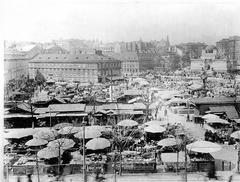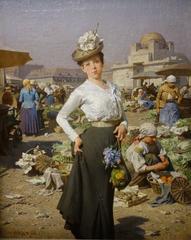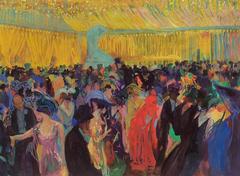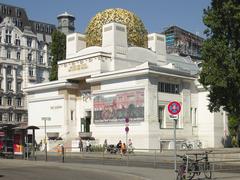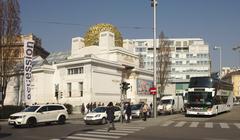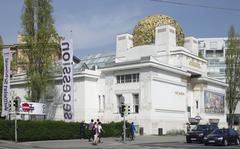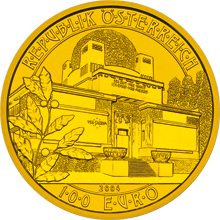
Secession Building Vienna: Visiting Hours, Tickets, and Complete Guide
Date: 14/06/2025
Introduction
The Secession Building (Secessionsgebäude) in Vienna is a cornerstone of modern art and architecture, representing the bold artistic revolution that swept through Austria at the dawn of the 20th century. Designed by Joseph Maria Olbrich and opened in 1898, this iconic Art Nouveau landmark—famed for its striking golden dome—embodies the spirit of the Vienna Secession movement. Its motto, “To every age its art, to art its freedom,” perfectly encapsulates the ideals of artistic autonomy and innovation championed by Gustav Klimt, Koloman Moser, Josef Hoffmann, and their contemporaries. Today, the Secession Building serves as both a monument to this transformative era and a vibrant contemporary exhibition space, making it a must-visit for art lovers and history enthusiasts alike (Vienna Itineraries; The Vienna Secession; The Art Bog).
This comprehensive guide covers the building’s history, architectural highlights, cultural significance, practical visitor information, current exhibitions, and essential tips to help you make the most of your experience.
Historical Overview and Cultural Significance
The Birth of the Vienna Secession
In 1897, a group of progressive artists led by Gustav Klimt broke away from Vienna’s conservative Künstlerhaus to form the Vienna Secession movement. Their goal was to foster a new platform for modern art, inspired by international trends and committed to the principle that every era deserves its own artistic expression. This vision is immortalized in the phrase inscribed above the building’s entrance:
“Der Zeit ihre Kunst, der Kunst ihre Freiheit” (“To every age its art, to art its freedom”) (Vienna Itineraries).
Architectural Vision
The city of Vienna granted the Secessionists a plot of land near the Naschmarkt, where Joseph Maria Olbrich designed a revolutionary exhibition hall. Eschewing the ornate historicism of the time, Olbrich’s design featured a white, windowless façade and the now-famous gilded laurel dome—affectionately known as the “golden cabbage.” The building’s geometric forms and minimal decoration marked a radical departure in Viennese architecture, influencing later modernist trends (Away to the City; The Vienna Secession).
Artistic Legacy
The Secession Building became a hub for avant-garde art, hosting exhibitions that introduced both Austrian and international artists to Viennese audiences. The 1902 exhibition, featuring Gustav Klimt’s Beethoven Frieze, exemplified the movement’s commitment to the Gesamtkunstwerk, or “total work of art,” integrating painting, sculpture, architecture, and design (Vienna Itineraries).
Despite internal tensions and external challenges—including wars, renovations, and political upheaval—the building has survived as a living symbol of Vienna’s cultural renaissance and remains a dynamic venue for contemporary art (The Vienna Secession).
Architectural Features and Symbolism
Exterior Form and “Golden Cabbage”
The Secession Building’s striking white cube and gilded dome, composed of 3,000 laurel leaves, immediately set it apart from its Baroque and Neo-Renaissance neighbors. The dome’s open latticework creates dramatic patterns of light and shadow, symbolizing creative openness and innovation (The Art Bog; Devil’s Advocates Journal).
Facade Inscriptions and Ornamentation
- Main Motto: “Der Zeit ihre Kunst, der Kunst ihre Freiheit” is carved above the entrance, encapsulating the Secession’s core philosophy.
- “Ver Sacrum” (“Holy Spring”): Inscribed on the left façade, referencing the Secession’s magazine and symbolizing renewal.
- Stylized floral motifs and geometric sculptures, including Othmar Schimkowitz’s gorgons at the entrance, reinforce the idea of a unified, all-encompassing art form (The Art Bog).
Interior Spaces
The building’s flexible, open-plan exhibition halls and high ceilings provide a neutral canvas for both permanent and rotating displays. Natural light and movable partitions were innovative for the era, allowing the Secessionists’ radical exhibition strategies to flourish (The Art Bog).
Visiting Information
Location
- Address: Friedrichstraße 12, 1010 Vienna, Austria
- Nearby: Naschmarkt, Vienna State Opera, Karlsplatz, Academy of Fine Arts
- Getting There:
- Metro: U1, U2, U4 (Karlsplatz, “Ausgang Secession” exit)
- Tram: D, 1, 2, 62, 71 (Opernring)
- Bus: 59A (Opernring)
(Secession official site; All About Vienna)
Opening Hours (as of June 2025)
- Tuesday to Sunday: 10:00 AM – 6:00 PM
- Monday: Closed
- During exhibition installations, only the Beethoven Frieze is open to visitors.
Admission and Tickets
- Adults: €12
- Audio Guide (English): €3
- Discounts: Seniors, children
- Free Admission: First Wednesday of every month (e.g., 2 April, 7 May, 4 June 2025)
- Ticket Purchase: Primarily on-site; online sales may be temporarily unavailable. Check the official website before visiting.
Accessibility
- The Beethoven Frieze and most exhibition areas are wheelchair accessible.
- Elevator available (left side of building); ring the bell or call +43-1-587 53 07-14 for assistance.
- Service animals welcome.
Highlights: What to See
Gustav Klimt’s Beethoven Frieze
Klimt’s monumental 34-meter-long Beethoven Frieze, painted in 1902, is permanently displayed in a climate-controlled basement gallery. This masterpiece visually interprets Beethoven’s Ninth Symphony and is considered a pinnacle of Viennese Art Nouveau (All About Vienna).
Rotating Contemporary Exhibitions
The Secession hosts approximately 15 exhibitions annually, featuring local and international artists across a range of media. Check the official website for current and upcoming shows.
- Notable current and upcoming exhibitions (2025):
- June Crespo (12 Sept – 16 Nov 2025)
- John Smith (12 Sept – 16 Nov 2025)
- Atelier Bow-Wow (12 Sept – 16 Nov 2025)
- Ariane Mueller, Jeremy Shaw, Francis Offman (until 31 Aug 2025)
- Tuesday@Secession program (until 26 Aug 2025)
(Museos.com)
Guided Tours and Audio Guides
- Guided tours: Available daily, usually from 10:00 AM to 1:00 PM (Fodor’s).
- Audio guides: €3, available in English and German (Visiting Vienna).
Visitor Experience and Facilities
- Gift Shop: Books, postcards, souvenirs themed around the Secession movement.
- Restrooms: Available on-site.
- Photography: Officially prohibited inside, especially for the Beethoven Frieze. Discreet, non-flash photography is often tolerated—always check with staff (The Geographical Cure).
- Signage: Exhibition texts are primarily in German, with English translations for major works. Audio guides highly recommended.
Tips for Visitors
- Time needed: 1–2 hours, depending on your interest in contemporary art and the Beethoven Frieze.
- Combine your visit: Explore the Naschmarkt or enjoy coffee at Café Museum (designed by Adolf Loos), both nearby.
- Best times: Weekday mornings or late afternoons are quieter; peak season is May–September.
- Free admission: First Wednesday of each month, but expect more visitors.
- Families: Children are welcome; some exhibitions may be more suitable for older visitors.
- Accessibility: Notify staff in advance for assistance; use Karlsplatz for the shortest walk (Visiting Vienna).
Frequently Asked Questions (FAQ)
Q: What are the Secession Building’s opening hours?
A: Tuesday to Sunday, 10:00 AM – 6:00 PM; closed on Mondays.
Q: How much is admission?
A: Adults €12, audio guides €3, discounts for seniors and children, free on the first Wednesday of each month.
Q: Is the building wheelchair accessible?
A: Yes, with elevator and barrier-free access.
Q: Can I take photos inside?
A: Photography is officially not allowed, but discreet, non-flash photos may be tolerated except in the Beethoven Frieze room.
Q: Are there guided tours?
A: Yes, daily between 10:00 AM and 1:00 PM; English audio guides are also available.
Q: Where can I buy tickets?
A: On-site; online sales may occasionally be unavailable—check the official website.
Contact and Further Information
- Address: Friedrichstraße 12, 1010 Vienna, Austria
- Phone: +43-1-587 53 07
- Website: Secession official site
- Social Media: Follow for updates on exhibitions and events.
Related Articles
Final Thoughts and Call to Action
The Secession Building is not only a testament to Vienna’s rich artistic heritage but also a dynamic venue for contemporary creativity. Its accessible facilities, central location, and diverse program of exhibitions make it an essential stop for any visitor to Vienna. For maximum enjoyment, consider booking guided tours, using audio guides, and exploring nearby cultural sites.
Enhance your experience by downloading the Audiala app for curated audio tours and the latest updates on Vienna’s cultural landmarks. Plan your visit today to immerse yourself in one of Europe’s most inspiring historical sites!
Sources
- Vienna Itineraries – Secession Building
- The Art Bog – The Vienna Secession: Redefining Art and Design
- ArchDaily – A Brief History of the Vienna Secession Design Movement
- Secession Official Site – Information & Tickets
- The Vienna Secession – The Secession Building
- Away to the City – Famous Buildings in Vienna
- All About Vienna – Secession: A Temple of Modern Art
- The Collector – Vienna Secession: The Beautiful Buildings of Austrian Art Nouveau
- Devil’s Advocates Journal – How the Vienna Secession Movement Shaped Austria’s Cultural Identity
- Fodor’s – Secession Building
- Visiting Vienna – Secession
- The Geographical Cure – The Vienna Secession Museum
- Museos.com – Vienna Exhibitions
- ArtsArtistsArtwork – Gustav Klimt & the Secession Movement
- DesignDash – Vienna Secession Foundation for Modern Art
- Secession.at – Building

